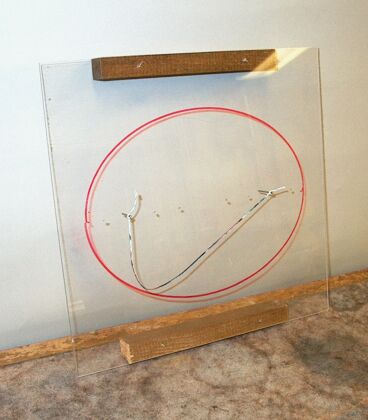
With this apparatus placed on the stage of an overhead projector, you can draw ellipses of various eccentricity and project them onto a screen. You choose how far apart the foci are by where you set the nails. The string keeps the pen point in such a path that the sum of its distances from the two foci is constant.
Moving objects that are subject to a central force and have sufficient energy travel in paths that are ellipses. A good example is the motion of the planets of the solar system around the sun, whose orbits are elliptical.
An ellipse is the locus of all points in a plane, the sum of whose distances from two fixed points is constant. Its equation is: x2/a2 + y2/b2 = 1, where a and b are constants. The two fixed points are called foci, and they always lie on the major (long) axis of the ellipse. The larger of a and b gives the length of the semimajor axis, and the smaller gives the length of the semiminor axis. Taking a as the semimajor axis, the sum of the distances from any point on the ellipse to the two foci is 2a. If we take the intercept of the ellipse at the semiminor axis, we then have a right triangle with the semiminor axis, b, the hypotenuse from the intercept to the focus, and the base from the focus to the center of the ellipse. The length of the hypotenuse is merely a (the same as the distance to the other focus), so the square of the distance, c, from the center to the focus is c2 = a2 - b2, or c = √(a2 - b2).
The eccentricity of the ellipse, that is, how flat it is, or how much it deviates from being a circle, is defined as e = c/a. If c = 0, the two foci coincide, and the ellipse is a circle. At the other extreme, c = a, and the ellipse flattens to a straight line segment between the foci.
On this apparatus, the sum of the distances from the foci to the point on the ellipse is fixed by the length of the string (which equals 2a). By selecting different holes in which to anchor the ends of the string, however, you can vary the distance between the foci, and thus change the eccentricity of the ellipse. The farther apart you place the foci, the more eccentric, or flatter, is the ellipse. The closer together you place the foci, the less eccentric, or more nearly circular, is the ellipse.
All of the planets in the solar system follow elliptical orbits about the sun, with the sun at one focus and nothing at the other focus. With the exceptions of the orbits of Mercury and Pluto (which is no longer classified as a planet), whose eccentricities are 0.206 and 0.249, respectively, the orbits of the planets are nearly circular. The one with the greatest eccentricity, 0.093, is that of Mars, and the least eccentric is that of Venus, with an eccentricity of 0.007. Earth’s orbit has an eccentricity of 0.017. Because the orbits of the planets are elliptical, as a planet travels around the sun its distance from the sun varies. The point at which the planet is closest to the sun is called its perihelion, and when the planet is farthest from the sun it is at its aphelion. In terms of the semimajor axis, a, and eccentricity, e, (and c, the distance from a focus to the center of the ellipse) at perihelion, the planet is at a distance a (1 - e) (or a - c) from the sun, and at aphelion, it is at a distance of a (1 + e) (or a + c) from the sun.
Johannes Kepler determined that orbits of the planets were as described above, by carefully studying the copious data compiled by Tycho Brahe from decades of observation and very accurate measurements of the positions of the planets and various stars. This constituted a refinement of the heliocentric model of the solar system proposed earlier by Copernicus, in which the planets traveled in circular orbits about the sun. Both models provided much simpler planetary orbits than those of the geocentric model proposed even earlier by Ptolemy, in which the sun and all the planets revolved around the earth, and which necessitated the use of epicycles – motion of the planets in small circles superimposed on their larger orbital motion. Because Copernicus’s model used circular orbits, it also required some use of epicycles, but the orbits were far simpler than those of the geocentric model. Kepler’s model completely eliminated the need for epicycles. From his analysis of Tycho Brahe’s data, Kepler arrived at three laws. The first law is that the orbits of the planets are ellipses, with the sun at one focus. The second law is that the line that connects the sun to any planet sweeps out equal areas of the ellipse in equal time intervals. Planets move faster when they are closer to the sun, and more slowly when they are farther from the sun. The third law is that the square of a planet’s orbital period is proportional to the cube of the semimajor axis of its orbit, essentially its average distance from the sun. An astronomical unit (A.U.) is the semimajor axis of Earth’s orbit around the sun. It turns out that if we use Earth years and A.U., the proportionality constant equals one, and if we call the orbital period p and the semimajor axis of the orbit a, we can write Kepler’s third law as p2 = a3.
References:
1. Thomas, George B., Jr. Calculus and Analytic Geometry (Reading, Massachusetts: Addison-Wesley Publishing Company, Inc., 1972)